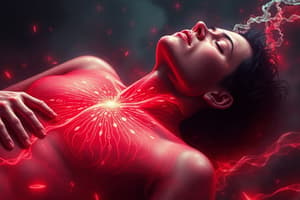Podcast
Questions and Answers
What condition is characterized by a bluish discoloration of the skin due to insufficient oxygen in the blood?
What condition is characterized by a bluish discoloration of the skin due to insufficient oxygen in the blood?
- Pallor
- Flushing
- Cyanosis (correct)
- Erythema
How can cyanosis in the lungs be most commonly detected?
How can cyanosis in the lungs be most commonly detected?
- Using imaging techniques
- Listening with a stethoscope
- By observing the skin color (correct)
- Through blood tests only
What is a common misconception about the causes of cyanosis?
What is a common misconception about the causes of cyanosis?
- It can be caused by cold temperatures
- It only occurs in patients with heart problems (correct)
- It is always a critical condition
- It only affects adults
What is the significance of recognizing cyanosis promptly?
What is the significance of recognizing cyanosis promptly?
Which of the following can potentially contribute to the development of cyanosis?
Which of the following can potentially contribute to the development of cyanosis?
Flashcards
Cyanosis
Cyanosis
A bluish discoloration of the skin and mucous membranes caused by a lack of oxygen in the blood.
Gasping breathing
Gasping breathing
A type of breathing that is shallow and rapid, typically associated with shortness of breath or respiratory distress.
Mouth-to-mouth resuscitation
Mouth-to-mouth resuscitation
A cardiopulmonary resuscitation (CPR) technique used to provide oxygen to the lungs and blood flow to the heart when someone is not breathing and has no pulse.
Suctioning
Suctioning
Signup and view all the flashcards
Peeling
Peeling
Signup and view all the flashcards
Study Notes
Asphyxia and Asphyxial Death
- Asphyxia is defined as interference with respiration or its function, resulting in lack of tissue oxygenation
- Key processes involved in respiration include receiving oxygen, using oxygen, and failure of tissue to utilize oxygen
- Asphyxia involves a breakdown in the respiration process, affecting aspects from oxygen intake, to blood transport, to oxygen use by tissues
- Key causes include defective cellular oxygenation (e.g., poisoning), mechanical obstruction by neck compression or closure of respiratory orifices (e.g., strangulation, hanging, smothering, crush asphyxia)
Learning Objectives
- Students should learn the definition, classifications, pathogenesis, and clinical picture of asphyxia
- Students should learn to diagnose asphyxia early to provide timely emergency treatment
- Students should be familiar with various types of violent asphyxia
- Students should understand drowning, including its mechanism, cause of death, post-mortem examination appearance, and medico-legal significance
Causes of Asphyxia
- Defective oxygenation at a cellular level, such as in poisoning
- Mechanical obstruction by the neck, such as hanging and strangulation (manual or by ligature)
- Mechanical airway obstruction, including closure of the external respiratory orifices (e.g., smothering)
- Mechanical obstruction interfering with respiratory movements (e.g., traumatic or crush asphyxia)
Stages of Asphyxia
- Dyspnea
- Convulsions
- Apnea
- Final stage
Pathophysiology of Asphyxia
- Increased carbon dioxide (PCO2) and decreased oxygen (PO2) levels
- Reduced haemoglobin (Hb) and cyanosis
- Respiratory and circulatory dysfunction
- Brain motor area malfunction, potentially leading to convulsions
- Centre paralysis
- Ultimately, death
Diagnosis of Asphyxia (General Signs)
- External signs:
- Swollen, cyanosed face
- Prominent eyeballs with conjunctival petechiae
- Swollen tongue (sometimes bitten)
- Froth oozing from the mouth/nostrils
- Deeply cyanosed lips, ears, and fingernails
- Internal signs:
- Pulmonary edema
- Froth in air passages
- Over-distended lungs
- Right-sided heart failure
- Right ventricular dilatation
Classical Signs of Asphyxia
- External: Petechial hemorrhages, frothy secretions, bluish discoloration (cyanosis)
- Internal: Dark blood and fluid in the heart, congested viscera, petechial hemorrhages, spots of cyanosis
Violent Asphyxia Deaths
- Violent asphyxia can be further categorized into
- Neck Violence (e.g., Hanging, Strangulation, Throttling)
- Drowning
- Suffocation (e.g., Smothering, Choking)
- Traumatic Asphyxia
Drowning
- Death from submersion of the mouth and nostrils under water
- Not necessarily complete body submersion
- Can be either "wet" (with aspiration of fluids causing hypoxic death- symptoms of drowning) or "dry" (without aspiration) (caused by laryngospasm: when water enters the nose and throat causing spasming of the larynx which prevents breathing)
Types of Drowning
- Primary drowning: Occurs within minutes of submersion. No successful treatment or resuscitation.
- Secondary drowning: Occurs within half an hour to several weeks of submersion. Death after successful treatment or resuscitation. Potential causes include severe lung infection, metabolic acidosis, pneumonia, or pulmonary edema.
Diagnosis of Drowning
- Signs of immersion (not sure signs of drowning): Cold, pale skin, granular/puckered skin, wrinkles/pleached skin, peeling of epidermis
- Highly suggestive signs: Cadaveric spasm, frothy secretions in the mouth/nose, elevated froth with increasing chest compression
Diagnosis of Drowning (Post-Mortem Internal and External Signs)
- Air passages: Full of froth, congested blood vessels in lungs, and debris (sand, mud, weeds).
- Lungs: Voluminous, filling the thoracic cavity, covering the heart, resembling emphysema.
- Lateral surfaces of lungs: Marked with rib impressions
- Diatom test: Detection of diatoms in the lungs and other organs; unreliable, use with caution and interpretation of results
Medico-Legal Investigation (MLI) of Drowning
- Determine if drowning was the cause of death
- Identify the manner of drowning (e.g., accidental, suicidal, homicidal)
- Determine the duration of immersion
Is the Drowning Case Suicidal, Homicidal, or Accidental?
- Difficult to determine but evidence from
- History and circumstantial evidence
- Previous suicidal attempts
- Signs of struggle or body trauma is useful
- Accidents commonly involve children and fishermen.
Studying That Suits You
Use AI to generate personalized quizzes and flashcards to suit your learning preferences.




